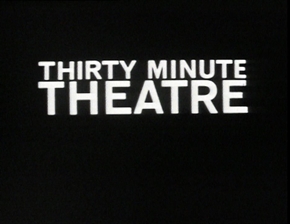Brain waves are rhythmic or repetitive neural activity in the central nervous system.
Contents
Brain wave or brainwave may also refer to:
Brain waves are rhythmic or repetitive neural activity in the central nervous system.
Brain wave or brainwave may also refer to:

BBC Two is a British free-to-air public broadcast television channel owned and operated by the BBC. It is the corporation's second flagship channel, and it covers a wide range of subject matter, incorporating genres such as comedy, drama and documentaries. BBC Two has a remit "to broadcast programmes of depth and substance" in contrast to the more mainstream and popular BBC One.
This is a timeline of the history of the British Broadcasting Corporation.
The Injustice Society is a group of supervillains in the DC Comics Universe. They are the main antagonists of the Justice Society of America.
A gamma wave or gamma rhythm is a pattern of neural oscillation in humans with a frequency between 30 and 100 Hz, the 40 Hz point being of particular interest. Gamma rhythms are correlated with large-scale brain network activity and cognitive phenomena such as working memory, attention, and perceptual grouping, and can be increased in amplitude via meditation or neurostimulation. Altered gamma activity has been observed in many mood and cognitive disorders such as Alzheimer's disease, epilepsy, and schizophrenia.

Coast is a BBC documentary series first broadcast on BBC Two television in 2005. It covers various subjects relating to both the natural and social history of the British coastline and also more recently, that of Britain's near neighbours. The seventh series followed a different format from previous series. In 2016, reports from the show were repackaged as Coast: The Great Guide, an eight part series on BBC Two.
Brainwave entrainment, also referred to as brainwave synchronization or neural entrainment, refers to the observation that brainwaves will naturally synchronize to the rhythm of periodic external stimuli, such as flickering lights, speech, music, or tactile stimuli.

Brainwave or Brainwave Jr. is a character in the DC Comics Universe, who is commonly portrayed as a superhero and son of the supervillain, Brain Wave, along with primarily being a member of the Infinity, Inc.

The Dreamachine, invented in 1959 by Brion Gysin and Ian Sommerville, is a stroboscopic flickering light art device that produces eidetic visual stimuli.
Flicker vertigo, sometimes called the Bucha effect, is "an imbalance in brain-cell activity caused by exposure to low-frequency flickering of a relatively bright light." It is a disorientation-, vertigo-, and nausea-inducing effect of a strobe light flashing at 1 Hz to 20 Hz, approximately the frequency of human brainwaves. The effects are similar to seizures caused by epilepsy, but are not restricted to people with histories of epilepsy.
Brain-reading or thought identification uses the responses of multiple voxels in the brain evoked by stimulus then detected by fMRI in order to decode the original stimulus. Advances in research have made this possible by using human neuroimaging to decode a person's conscious experience based on non-invasive measurements of an individual's brain activity. Brain reading studies differ in the type of decoding employed, the target, and the decoding algorithms employed.
Brainwaves is a single-panel cartoon series by Betsy Streeter. Brainwaves has been described as "a single-panel stream of consciousness about the infinite absurdity of everyday life."

Electroencephalography (EEG) is a method to record an electrogram of the spontaneous electrical activity of the brain. The biosignals detected by EEG have been shown to represent the postsynaptic potentials of pyramidal neurons in the neocortex and allocortex. It is typically non-invasive, with the EEG electrodes placed along the scalp using the International 10–20 system, or variations of it. Electrocorticography, involving surgical placement of electrodes, is sometimes called "intracranial EEG". Clinical interpretation of EEG recordings is most often performed by visual inspection of the tracing or quantitative EEG analysis.
This is a list of British television related events from 1965.
The Force Trainer is a Star Wars-themed toy which creates the illusion of performing Force-powered telekinesis.
Mindflex is a toy by Mattel by which, according to its description, the operator uses their brain waves to steer a ball through an obstacle course. Brain waves are registered by the enclosed EEG headset, which allows the user to control an air stream by concentrating, thus lifting or lowering a foam ball. The game was released in the fall of 2009, and uses the same microchip as the MindSet from NeuroSky and homebuilt EEG machines.

The UCL Queen Square Institute of Neurology is an institute within the Faculty of Brain Sciences of University College London (UCL) and is located in London, United Kingdom. Together with the National Hospital for Neurology and Neurosurgery, an adjacent facility with which it cooperates closely, the institute forms a major centre for teaching, training and research in neurology and allied clinical and basic neurosciences.
Doctor Who: Thirty Years in the TARDIS is a special 50-minute television documentary celebrating the 30th anniversary of the science-fiction series Doctor Who. It was originally broadcast on Monday, 29 November 1993, on BBC1. The programme was the first BBC-produced, in-depth documentary chronicling Doctor Who since Whose Doctor Who was broadcast in April 1977, and it followed a 30-minute, categorized compilation of archive clips broadcast in 1992 on BBC2 entitled Resistance is Useless. The show featured many clips from the show's episodes, and interviews with the cast and crew. Several iconic scenes from the show were recreated, with young actor Josh Maguire playing the part of a child imagining himself involved in the settings.

Epilepsy Ireland is an Irish charity that provides support, information and advice to people with epilepsy. Founded in 1966, the organisation is based in Dublin, with nine regional offices throughout Ireland.

Thirty-Minute Theatre was a British anthology drama series of short plays shown on BBC Television between 1965 and 1973, which was used in part at least as a training ground for new writers, on account of its short running length, and which therefore attracted many writers who later became well known. It was produced initially by Harry Moore, later by Graeme MacDonald, George Spenton-Foster, Innes Lloyd and others. Thirty-Minute Theatre began on BBC2 in 1965 with an adaptation of the black comedy Parson's Pleasure. Dennis Potter contributed Emergency – Ward 9 (1966), which he partially recycled in the much later The Singing Detective (1986). In 1967 BBC2 launched the UK's first colour service, with the consequence that Thirty-Minute Theatre became the first drama series in the country to be shown in colour.
Brain Wave is a supervillain appearing in the DC Comics Universe. He is a recurring foe of the Justice Society of America, a founding member of the Injustice Society, and the father of the superhero Brainwave.